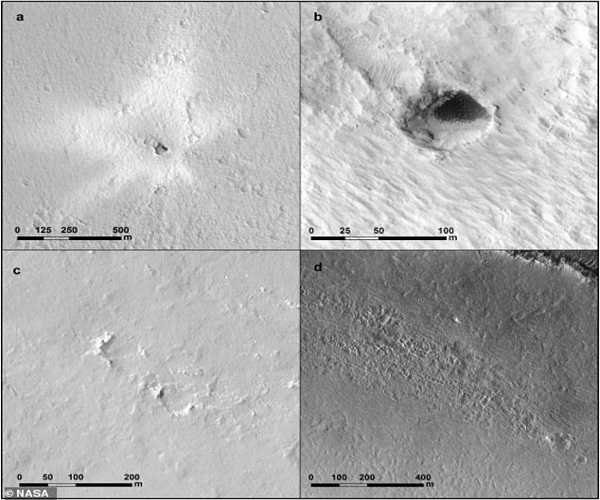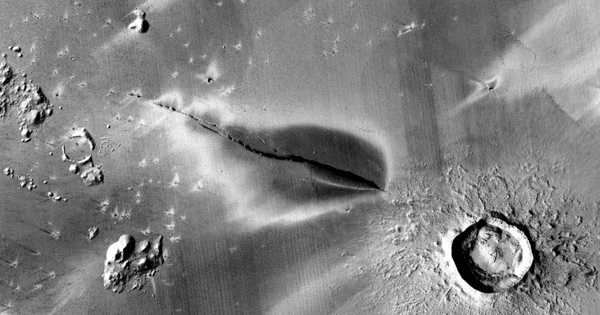New observations indicate that Mars may still be volcanically active, raising the prospect of habitable conditions on Mars’ near-surface in recent history. Ongoing research looks into the possibility that the most recent volcanic activity on Mars, which occurred around 50,000 years ago, was caused by a nearby asteroid impact at the same time.
According to a new study by researchers at the University of Arizona’s Lunar and Planetary Laboratory and the Planetary Science Institute, evidence of recent volcanic activity on Mars suggests that eruptions could have occurred within the last 50,000 years.
The majority of volcanism on Mars occurred between 3 and 4 billion years ago, with smaller eruptions in isolated locations possibly continuing as recently as 3 million years ago. But, until now, there had been no evidence that Mars was still volcanically active.
Researchers discovered a previously unknown volcanic deposit using data from Mars orbiting satellites. They describe their findings in the journal Icarus in the paper “Evidence for geologically recent explosive volcanism in Elysium Planitia, Mars.”
“This could be the youngest volcanic deposit ever documented on Mars,” said lead study author David Horvath, a postdoctoral researcher at UArizona who is now a research scientist at the Planetary Science Institute. “If we compressed Mars’ geologic history into a single day, this would have happened in the last second.”
New observations reveal that Mars could still be volcanically active, raising the possibility for habitable conditions in the near-surface of Mars in recent history.
A 20-mile-long volcanic fissure was surrounded by an 8-mile-wide, smooth, dark deposit created by the volcanic eruption. “When we first noticed this deposit, we knew it was something special,” said study co-author and senior author Jeff Andrews-Hanna, an associate professor at the UArizona Lunar and Planetary Laboratory. “The deposit was unlike anything else found in the region, or indeed on Mars, and resembled features created by older volcanic eruptions on the Moon and Mercury.”
Further investigation revealed that the material’s properties, composition, and distribution are consistent with a pyroclastic eruption – an explosive eruption of magma driven by expanding gasses, similar to the opening of a shaken can of soda.
The majority of the volcanism in the Elysium Planitia region and elsewhere on Mars consists of lava flowing across the surface, similar to recent eruptions in Iceland being studied by co-author Christopher Hamilton, an associate professor of lunar and planetary sciences at the University of Arizona. Although there are numerous examples of explosive volcanism on Mars, they all happened a long time ago. This deposit, on the other hand, appears to be unique.

“This feature appears to be a relatively fresh and thin deposit of ash and rock overlying the surrounding lava flows, representing a different style of eruption than previously identified pyroclastic features,” Horvath said. “This eruption could have thrown ash up to 6 miles into Mars’ atmosphere. It’s possible that these types of deposits were more common in the past but have since been eroded or buried.”
The recent eruption is located approximately 1,000 miles (1,600 kilometers) from NASA’s InSight lander, which has been studying seismic activity on Mars since 2018. Two Marsquakes, the Martian equivalent of earthquakes, were discovered to originate in the region around the Cerberus Fossae, and recent research suggests that these could be caused by magma movement deep underground.
“The young age of this deposit absolutely raises the possibility that there is still volcanic activity on Mars,” Horvath said. “It is also intriguing that recent Marsquakes detected by the InSight mission are sourced from the Cerberus Fossae.” Indeed, the team of researchers predicted that this would be a likely location for Marsquakes months before NASA’s InSight lander landed on Mars.
A volcanic deposit like this one raises the possibility of recent habitable conditions beneath Mars’ surface, according to Horvath. “The interaction of ascending magma and this region’s icy substrate could have provided favorable conditions for microbial life relatively recently, raising the possibility of extant life in this region,” he said.
Similar volcanic fissures in this region caused massive floods as recently as 20 million years ago, when groundwater erupted onto the surface. Andrews-research Hanna’s team is still looking into the eruption’s causes. Pranabendu Moitra, a research scientist in the UArizona Department of Geosciences, has been investigating the eruption’s mechanism.
Moitra, an expert in similar explosive eruptions on Earth, created models to investigate the possible cause of the Martian eruption. He suggests in a forthcoming paper in the journal Earth and Planetary Science Letters that the explosion could have been caused by gases already present in Martian magma, or it could have occurred when the magma came into contact with Martian permafrost.
“The ice melts to water, mixes with the magma, and vaporizes, causing the mixture to explode violently,” Moitra explained. “It’s like pouring gasoline on a fire when water and magma mix.” He also points out that the youngest volcanic eruption on Mars occurred only 6 miles (10 kilometers) from the planet’s youngest large-impact crater, Zunil, which is 6-miles wide. “The ages of the eruption and the impact are indistinguishable,” Moitra said. “This raises the possibility, however speculative, that the impact actually triggered the volcanic eruption.”
Several studies have discovered evidence that large Earth quakes can cause magma stored beneath the surface to erupt. Moitra explained that the impact that formed the Zunil crater on Mars would have shook the Red Planet like an earthquake.
While the more dramatic giant volcanoes on Mars, such as Olympus Mons, the solar system’s tallest mountain, tell a story of the planet’s ancient dynamics, the current hotspot of Martian activity appears to be in the relatively featureless plains of the planet’s Elysium region.
Andrews- Hanna believes it is remarkable that one region is home to the epicenters of current earthquakes, recent floods, recent lava flows, and now an even more recent explosive volcanic eruption. “This may be the most recent volcanic eruption on Mars,” he said, “but I’m confident it won’t be the last.”
According to Andrews-Hanna, the volcanic deposit described in this study, along with ongoing seismic rumbling in the planet’s interior detected by InSight and possible evidence for methane plume releases into the atmosphere detected by NASA’s MAVEN orbiter, indicate that Mars is far from a cold, inactive world. “It appears that all of these data are telling the same story,” he said. “Mars isn’t gone.”















